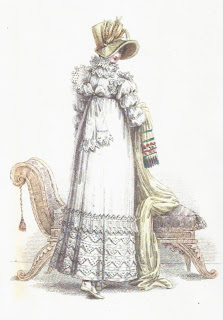Susan reporting:
After the number of interesting comments following my
post on 18th c. stays last week, I made the question of stay-lacing one of my top priorities for my quickie trip to
Colonial Williamsburg this week. The majority of women employees who are wearing historic dress are also wearing stays (the ones without stays are representing women of the past who would not ordinarily wear them, such as enslaved African American women and Native American women.)
Most said that they had a friend, sister, spouse, boyfriend, or co-worker who helped them lace and tie their stays in the morning – which, really, must have been the case for most 18th c. women as well. But there were a few hardy souls who said they could and did put their stays on by themselves, and that, with a little practice, it wasn't that difficult. Abby Cox, a costume scholar and currently a seamstress in CW's Costume Design Center, volunteered to show how it's done.
Click on the photographs to enlarge them for detail.A few words about Abby's stays,
top: Replicating the style of the 1770s, the stays are made of lavender worsted wool over layers of linen, and edged with narrow strips of white kidskin. Abby stitched the stays herself entirely by hand, aiming for a hand-stitch gauge of 10 stitches per inch. This is no casual undertaking: Abby estimates that stitching the rows of narrow channels took about nine days, while shaping the bones and fitting them into the channels took another two days of work. Eighteenth century women would not have attempted to make their own stays, but instead would purchase bespoke stays from a skilled stay-maker (almost always male), who would have made nothing else.

First Abby lay her stays out on a table and laced them very loosely, using a bone bodkin (a large-eyed needle) to draw the lace – a cord much like a shoelace – through the eyelets. 18th c. stays are spiral-laced, meaning that the lace goes from side to side in a zig-zag pattern. With a servant or other helper to draw the stays tight, the lacing would begin with a looped knot at the bottom and go upward, fastening at the top. Solo-lacing must go the opposite direction, with the beginning knot at the top eyelet.
Once Abby had the lace through all the eyelets, she slipped the stays over her head and over her shift, and settled them in place,
above right. Then, reaching around behind, she gradually began pulling the lace tight,
above left. The goal with 18th c stays is about an inch or two gap. The edges are not intended to meet, so as you can see, Abby did an admirable job, working by feel. When she reached the bottom, she pulled the lace tight, and wrapped it several times around her waist before securing it with a bow,
lower right. Yes, Abby made it look easy,
lower left, but this was clearly a process that required practice as well as flexibility!
Why didn't women wear front-lacing stays, which would have been so much more simple? Tradition, and fashion: back-lacing created a smoother, flatter front that was the ideal. The majority of surviving 18th c. stays are back-laced, though there are a handful that lace in front, designed to please some forgotten independent ladies.
Many thanks to Abby Cox for serving as my 18th c. lady, and to Angela Burnley of Burnley & Trowbridge for sharing her expertise and hospitality.Photographs copyright ©2011 Susan Holloway Scott




























